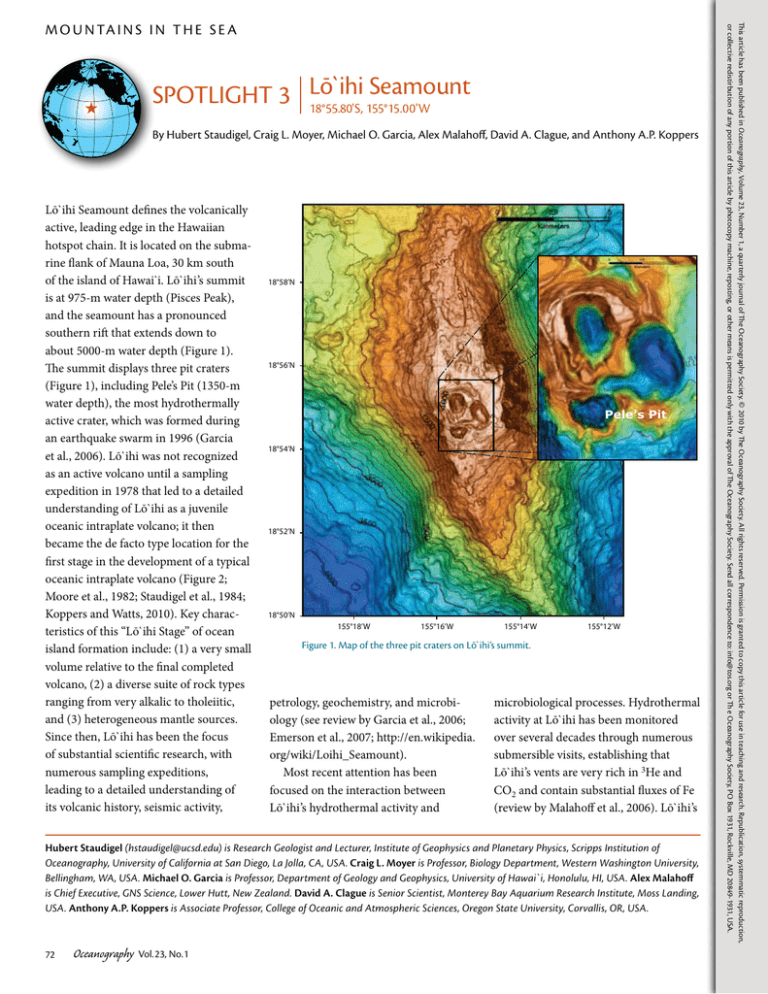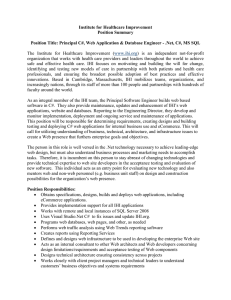SPOTLIGHT 3 Lō`ihi Seamount 18°55.80'S, 155°15.00'W
advertisement

Seamount SPOTLIGHT 3 Lō`ihi 18°55.80'S, 155°15.00'W By Hubert Staudigel, Craig L. Moyer, Michael O. Garcia, Alex Malahoff, David A. Clague, and Anthony A.P. Koppers Lō`ihi Seamount defines the volcanically active, leading edge in the Hawaiian hotspot chain. It is located on the submarine flank of Mauna Loa, 30 km south of the island of Hawai`i. Lō`ihi’s summit is at 975-m water depth (Pisces Peak), and the seamount has a pronounced southern rift that extends down to about 5000-m water depth (Figure 1). The summit displays three pit craters (Figure 1), including Pele’s Pit (1350-m water depth), the most hydrothermally active crater, which was formed during an earthquake swarm in 1996 (Garcia et al., 2006). Lō`ihi was not recognized as an active volcano until a sampling expedition in 1978 that led to a detailed understanding of Lō`ihi as a juvenile oceanic intraplate volcano; it then became the de facto type location for the first stage in the development of a typical oceanic intraplate volcano (Figure 2; Moore et al., 1982; Staudigel et al., 1984; Koppers and Watts, 2010). Key characteristics of this “Lō`ihi Stage” of ocean island formation include: (1) a very small volume relative to the final completed volcano, (2) a diverse suite of rock types ranging from very alkalic to tholeiitic, and (3) heterogeneous mantle sources. Since then, Lō`ihi has been the focus of substantial scientific research, with numerous sampling expeditions, leading to a detailed understanding of its volcanic history, seismic activity, 18°58’N 18°56’N Pele’s Pit 18°54’N 18°52’N 18°50’N 155°18’W 155°16’W 155°14’W 155°12’W Figure 1. Map of the three pit craters on Lō`ihi’s summit. petrology, geochemistry, and microbiology (see review by Garcia et al., 2006; Emerson et al., 2007; http://en.wikipedia. org/wiki/Loihi_Seamount). Most recent attention has been focused on the interaction between Lō`ihi’s hydrothermal activity and microbiological processes. Hydrothermal activity at Lō`ihi has been monitored over several decades through numerous submersible visits, establishing that Lō`ihi’s vents are very rich in 3He and CO2 and contain substantial fluxes of Fe (review by Malahoff et al., 2006). Lō`ihi’s Hubert Staudigel (hstaudigel@ucsd.edu) is Research Geologist and Lecturer, Institute of Geophysics and Planetary Physics, Scripps Institution of Oceanography, University of California at San Diego, La Jolla, CA, USA. Craig L. Moyer is Professor, Biology Department, Western Washington University, Bellingham, WA, USA. Michael O. Garcia is Professor, Department of Geology and Geophysics, University of Hawai`i, Honolulu, HI, USA. Alex Malahoff is Chief Executive, GNS Science, Lower Hutt, New Zealand. David A. Clague is Senior Scientist, Monterey Bay Aquarium Research Institute, Moss Landing, USA. Anthony A.P. Koppers is Associate Professor, College of Oceanic and Atmospheric Sciences, Oregon State University, Corvallis, OR, USA. 72 Oceanography Vol.23, No.1 This article has been published in Oceanography, Volume 23, Number 1, a quarterly journal of The Oceanography Society. © 2010 by The Oceanography Society. All rights reserved. Permission is granted to copy this article for use in teaching and research. Republication, systemmatic reproduction, or collective redistirbution of any portion of this article by photocopy machine, reposting, or other means is permitted only with the approval of The Oceanography Society. Send all correspondence to: info@tos.org or Th e Oceanography Society, PO Box 1931, Rockville, MD 20849-1931, USA. M O U N TA I N S I N T H E S E A distinct He isotope compositions allowed Lupton (1996) to trace its hydrothermal plumes over 2,000 km toward the east, demonstrating the use of hydrothermal plumes as tracers for mid-water-depth ocean circulation. The Fe-hydroxiderich nature of the Lō`ihi hydrothermal vents led to detailed studies of novel microbial communities thriving on Fe-oxidation and the discovery of a new genus of Proteobacteria, Mariprofundus ferrooxydans (Emerson et al., 2007). Lō`ihi Seamount is now recognized for its potential value to observatory-based science, including the (short-lived) fiber-optic-linked HUGO geophysical observatory in 1997 (http://www. soest.hawaii.edu/HUGO/hugo.html) and the FeMO microbial observatory for Fe-oxidizing microbes in 2006 (http://earthref.org/FEMO). REFERENCES Emerson, D., J.A. Rentz, T.G. Lilburn, R.E. Davis, H. Aldrich, C. Chan, and C.L. Moyer. 2007. A novel lineage of proteobacteria involved in formation of marine Fe-oxidizing microbial mat communities. PLOSOne, doi:10.1371/journal. pone.0000667. Garcia, M.O., J. Caplan-Auerbach, E.H. De Carlo, M.D. Kurz, and N. Becker. 2006. Geology, geochemistry and earthquake history of Loihi Seamount, Hawaii’s youngest volcano. Chemie der Erde-Geochemistry 66(2):81–108. Koppers, A.A.P., and A.B. Watts. 2010. Intraplate seamounts as a window into deep Earth processes. Oceanography 23(1):42–57. Lupton, J.E. 1996. A far-field hydrothermal plume from Loihi Seamount. Science 272(5264):976–979. Malahoff, A., I.Ya. Kolotyrkina, B.P. Midson, and G.J. Massoth. 2006. A decade of exploring a submarine intraplate volcano: Hydrothermal manganese and iron at Lō`ihi Volcano, Hawai`i. Geochemistry, Geophysics, Geosystems 7, Q06002, doi:10.1029/2005GC001222. Moore, J.G., D.A. Clague, and W.R. Normark. 1982. Diverse basalt types from Loihi seamount, Hawaii. Geology 10(2):88–92. Staudigel, H., A. Zindler, S.R. Hart, T. Leslie, C.Y. Chen, and D. Clague. 1984. The isotope systematics of a juvenile intraplate volcano: Pb, Nd, and Sr isotope ratios of basalts from Loihi Seamount, Hawaii. Earth and Planetary Science Letters 69(1):13–29. Figure 2. Seafloor images from Lō`ihi Seamount. (a) Pillow fragment breccia near Marker 18 on the western end of Pele’s Pit, the location of a microbial exposure experiment; the breccia fragments are coated with Fe-oxide stain. (b) Fe-oxide chimlets in Pele’s Pit. (c) Pillow lavas and (d) pillow breccia on the south rift as a substrate for the growth of a coral with a brittle star. Oceanography March 2010 73






